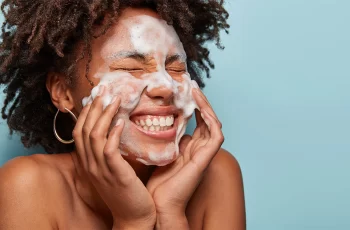
This all-star skincare ingredient is a favorite if you want to lock in moisture and fight signs of aging. Here’s how it works and what to look out for in the ingredient list. If there’s one skincare ingredient that hydrates your skin fast, it’s hyaluronic acid. You’ll find it as an active ingredient in just about every category of skincare (serums, cleansers, moisturizers, etc.).
It’s everywhere for a reason: Not only is hyaluronic acid great for hydrating your skin, but it can also minimize signs of aging, as plump, hydrated skin can make fine lines and wrinkles less noticeable.
Here’s a scientific guide that explains the basics of hyaluronic acid. What is hyaluronic acid? According to research, it’s technically a group of sugar molecules called polysaccharides.
The Cleveland Clinic notes that these molecules act as buffers and lubricants and are naturally found in the body’s connective tissue.
Over time, the amount of hyaluronic acid stored in the body decreases. Research suggests age is one reason, but another suggests environmental factors like smoking and air pollution may also speed up the process. That’s all bad news.
The good news is that topical products containing hyaluronic acid, either as part of a moisturizer’s ingredient list or as the main ingredient in a serum, can help replenish these depleted supplies, says Dr. Bonnie Gasquet, an internist at Studio Health Medical Center in Belcher, Louisiana.
“Hyaluronic acid attracts and binds to water molecules, increasing the moisture content of the skin,” says Dr. Shari Marchbein, a board-certified dermatologist with a private practice in New York City. They can absorb more than a thousand times their own weight in water, says Dr. Marchbein.
What are the benefits of hyaluronic acid? The main benefit of hyaluronic acid is hydration and its incredible ability to retain moisture. Marchbein says to understand how important moisture is to your skin, you first need to know that dehydrated skin (when the top layer of skin doesn’t have enough water) can look dry, rough, and flaky. This isn’t just an aesthetic issue. Dry skin can be dangerous. “Dehydrated skin can’t
“maintain a sufficiently intact skin barrier, making the skin more susceptible to damage from external and environmental sources,” Marchbein says.
When the skin barrier isn’t intact, bacteria can invade and cause infection, according to one study. A weakened skin barrier may be linked to a number of skin conditions, including dry skin, atopic dermatitis, rosacea, and acne,
such studies.
Then hydrated skin is for you. “Skin hydration is important because hydrated skin looks plumper, healthier, and more vibrant,” Marchbein says. She’ll also look younger if that’s one of your goals.
According to research, skin aging is associated with a loss of moisture from the skin, and hyaluronic acid is an important ingredient to fight or reverse those signs. “Due to its water-attracting properties, hyaluronic acid can cause dry, dimpled, or
“wrinkle” areas to improve and fight skin aging,” says Dr. Gasquet.
One study found that an over-the-counter anti-wrinkle cream containing hyaluronic acid reduced the depth of wrinkles around the lips and eyes by 10 to 20 percent over three months. Skin firmness was also improved by 13 to 30 percent.
Gasquet recommends using products with hyaluronic acid, especially during the winter months when skin is at its driest. But even those who don’t struggle with dryness may want to incorporate hyaluronic acid into their skincare routine.
It can give skin a healthy glow, says Kenneth Rothaus, MD, a board-certified plastic surgeon at Rothaus Plastic Surgery in New York City. Marchbein recommends a hyaluronic acid-rich moisturizer for all ages.
“It’s never too early to start good skin care,” she says. 3 Types of Hyaluronic Acid: How They Differ. There are three types of hyaluronic acid: Hydrolyzed hyaluronic acid is hyaluronic acid that has been broken down into elements that are strong enough to penetrate the skin, Gasquet says.
It’s hydrating, but not the most hydrating option, so it’s best for people with oily or combination skin, who want to avoid over-moisturizing. Sodium hyaluronate penetrates deeper into the skin and provides better results, though the results won’t last as long, Gasquet says.
“Sodium hyaluronate is best for people with normal skin because it allows moisture to penetrate, but don’t necessarily need the intense, long-lasting effects that you might find in a serum.”
Sodium acetylated hyaluronate has the benefits of sodium hyaluronate, but with longer-lasting effects. It’s best for people who need moisture, such as: B. People with dry skin, those who live in dry climates. Or those who are looking for something for dry winters.
There’s also ingestible hyaluronic acid, a capsule filled with the active ingredient. One study showed that by taking a supplement, hyaluronic acid levels remained stable and the effects lasted. It seems to work:
Researchers found that participants who took 120 milligrams (mg) of hyaluronic acid daily for 12 weeks had improvements in skin wrinkles and overall skin condition. However, more research is needed on taking hyaluronic acid orally.
Are there any side effects of hyaluronic acid that I should know about? Marchbein says hyaluronic acid is generally safe for all skin types and doesn’t usually cause side effects when used topically. “Hyaluronic acid comes naturally in our skin, so it shouldn’t cause any problems,” says Dr. Rossos.
“When patients complain of rashes or other problems with products containing hyaluronic acid, it’s usually due to a problem with another ingredient, such as one of the preservatives that prolongs the life of the product, but some of these preservatives, including parabens, are not safe., which releases formaldehyde, substances and isothiazolinones that can cause irritation, according to DermNet. Marchbein noted that many injectable fillers also contain hyaluronic acid, and while the ingredient itself is safe, the procedure can be risky and should be performed by a physician certified by the American Board of Dermatology or the American Board of Plastic Surgery. Uses for Hyaluronic Acid: What to Look for in Topical Products Name a skin care category and chances are there’s a product with hyaluronic acid. You can find this ingredient in many products, including: serums, masks, eye creams, moisturizers, cleansers, lip balms. Before you buy a topical product, follow these steps: Check for allergens and vitamin C. Gasquet advises being wary of ingredients you don’t like, are allergic to, or have caused irritation in the past. Look for hyaluronic acid products that also have vitamin C as an ingredient. The two ingredients work together to increase effectiveness, according to the Cleveland Clinic. Pay attention to molecular weight. When looking for a product, check to see if its molecular weight is listed. This isn’t always the case, but it’s worth looking for because it can give you an idea of the product’s effectiveness. According to one study, lower molecular weight acids (such as 50 kilodaltons vs. 2,000 kilodaltons) have a higher molecular weight than hyaluronic acid. Dalton) can penetrate the skin more easily and has been shown to fight wrinkles more effectively. This study found that even a 0.1% concentration of hyaluronic acid increased hydration and elasticity, even though most products contain 1% or 2%. Check if alcohol is listed. Alcohol can counteract the moisturizing effects of this ingredient. “Isopropyl alcohol can be very drying to the skin, making it prone to cracking, causing breakouts, and allowing irritants and bacteria to get in where they shouldn’t,” Gasquet says. “Plus, the ‘drying effect’ means cells don’t get plumped up, which is the exact opposite of what we want.” She advises paying attention to where the alcohol is on the ingredient list. “Ingredients are listed in order of concentration. So if it’s one of the first six, it can dry out the product,” Gasquet says.
Avoid fragrance. Products with added fragrance can cause irritation or rashes in people with sensitive skin, says Nazanin Saedi, MD, of Dermatology Associates Laser and Cosmetic Surgery in Plymouth Meeting, Pennsylvania,
so it’s best to stay away from it. Fragrance can also cause contact dermatitis, a rash, according to the Cleveland Clinic. This can happen anywhere from minutes to days after contact with the trigger. Don’t be afraid of water. Hyaluronic acid products often have water as the
first ingredient. It may seem like a useless ingredient, like it dilutes the product, but it actually helps the hyaluronic acid be more effective. “Unlike creams, oils, or gels, water-based products penetrate the skin more easily,” Gasquet says.


